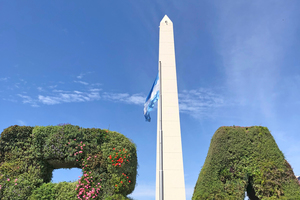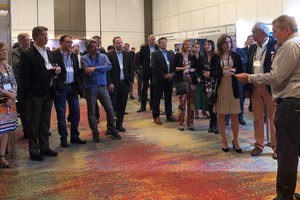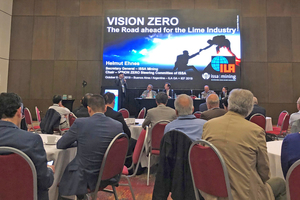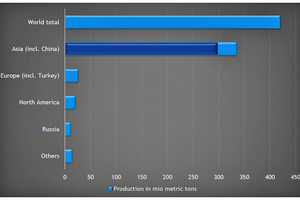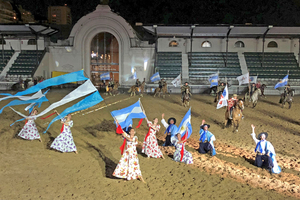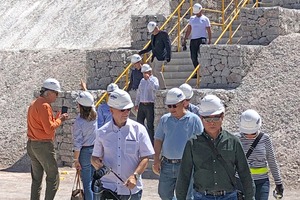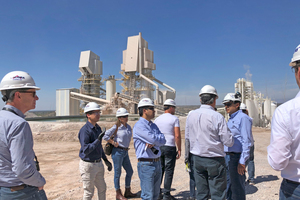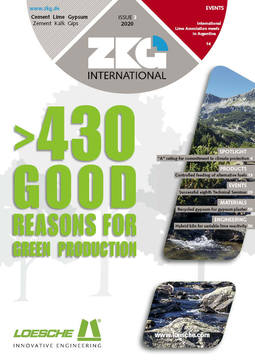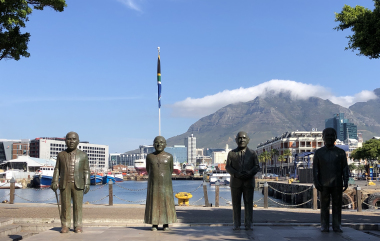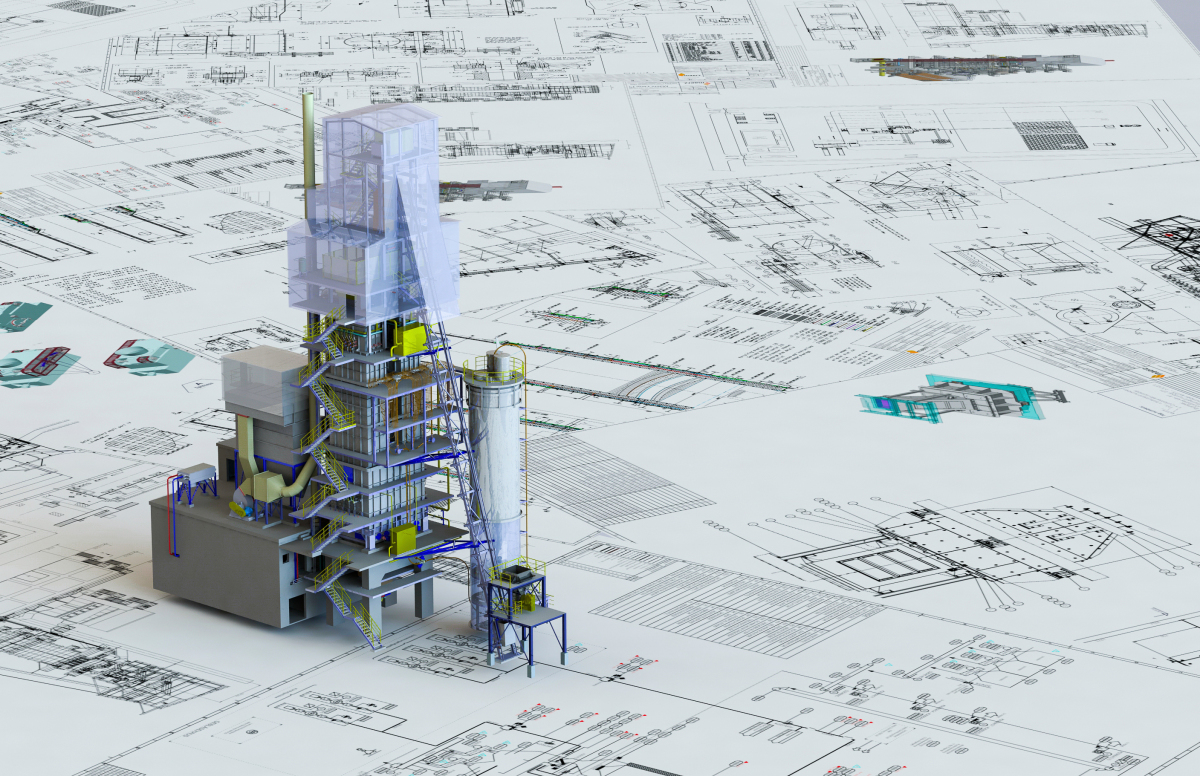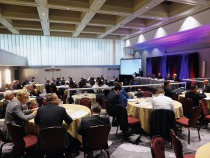International Lime Association meets in Argentina
From 09.10.-12.10.2019, around 100 delegates from 19 countries met for the General Assembly and Information Exchange Forum of the International Lime Association (ILA) in Buenos Aires/Argentina. On the subsequent tour to the Cefas plant Padre Bueno in Cienaguita/San Juan the delegates were given the opportunity to visit a modern Argentinian lime plant.
1 Exchange between lime producers and suppliers
Following the ILA General Assembly, the attendees met on Wednesday evening for the Welcome Reception in the exhibition area. Twelve suppliers had travelled to Buenos Aires to inform management professionals in the international lime industry about their range of products and services as part of an exhibition. The current ILA President Paul Ellis welcomed the 99 delegates to Argentina, and in his opening address he thanked everyone involved in the preparation for this event including the colleagues from Argentina and Chile, Calidra and Cefas, for their great support in organizing the event as well as Cefas for hosting the group on the plant tour. He also expressed his great thanks to the German organization team under the direction of the Secretary General Thomas Stumpf.
2 Overview of the global lime industry
On the second day, as part of the Information Exchange Forum, experts presented the current situation in the lime industry in various countries worldwide, the challenges for the branch and its future prospects. Top topics were sustainability and emission reduction, process and technical innovations and the Internet of Things (IoT). The representatives of the supplier industry then presented their latest projects, plants and case studies.
Paul Ellis opened the forum and warmly welcomed the two new ILA members, Cefas, Argentina, and Soprocal, Chile.
In his opening address as ILA Secretary General, Thomas Stumpf, Germany, pointed out that the ILA was “a valuable platform for exchange of information and experience on all kinds of lime-related topics for all of us”, enabling many first contacts to be established and addressing trends and technologies, challenges and opportunities for the industry.
In 2018, world lime production stood at more than 400 million metric tonnes, China alone accounts for just under 300 million metric tonnes.
2.1 The lime industry in South America and Argentina
Pedro Brandi, Cefas, Argentina, gave an overview on “The lime industry in South America and Argentina”.
The Argentinian lime producer Cefas was established in 1995 with the takeover of a company with plants in the central and western parts of the country. In 1997, Cefas acquired quarries and a plant for the production of hydraulic lime near Buenos Aires. In 1998, it integrated three lime plants and quarries in the centre and west of the country, making it one of the leading construction lime companies operating in Argentina today. In 2009, work commenced on the construction of the Padre Bueno plant on a greenfield site in the west of the country. In 2016, Cefas merged with Grupo Calidra. In 2019, Sibelco’s lime business was taken over, with three plants in the west of Argentina and a sales centre in Santiago de Chile.
For the Argentinian lime industry with its 17 plants at present, Brandi expects increasing production capacities for lime up to 2023 (from 1 766 000 t/a in 2018 to 2 081 000 t/a in 2023), he sees the production of hydraulic lime remaining at a constant level. Reason for the increasing lime demand is first the increasing consumption in the construction sector, especially, however, in mining, here high increase rates are expected. Brandi sees the challenges for the South American lime industry as the “need for greater economies of scale, larger factories, modernization (greater energy, labour and stone efficiency) and demand for higher-quality products”.
Waldo Perez, Soprocal, Chile, then presented the Chilean lime company Soprocal, which was founded in 1940 by the brothers Jorge and Alfonzo Rozas Ossa. The lime plant Soprocal Calerías e Industrias S.A. is located in the central part of the country, the limestone deposits in Río Colorado and Cap Concepción. Sales stand at 130 000 t lime, caustic lime and slaked lime as well as 200 000 t carbonates.
2.2 Vision Zero – The road ahead for the lime industry
Helmut Ehnes, Secretary General – ISSA Mining, appealed to the lime industry to share existing knowledge in work health and safety and to get involved in the ISSA Mining, which celebrated its 50-year anniversary in 2019. He explained to the attendees the three dimensions of Vision Zero: Safety at workplaces – the “classic” approach, Healthy work – the undervalued factor and Wellbeing by leadership and a prevention culture and the seven golden rules. Vision Zero now has more than 6750 partners across the world.
Ehnes outlined the ILA’s plan to present for the first time an “ILA Health & Safety Award” at the anniversary event in Paris in 2020. This is to be awarded in several categories. The goals were to stimulate safety & health, prevention culture and to raise awareness; motivate workers, teams, managers; honour and motivate the best; develop, collect and distribute innovative solutions, learn from each other and share good practices, and support positive image of the global lime industry.
Other activities could include a newsletter and employee training.
3 Sustainability and emission reduction
Mathieu Bouchard, Graymont, Canada, opened the second session of papers with “Canada – climate change regulatory landscape update”. The Canadian government has been working since 2015 with the provinces and territories to put a price on carbon. The federal system went into effect in 2019. Canada’s objective is to reduce national emissions to 30 % below 2005 levels by 2030. Lime and cement industries have been recognized as being the most trade-exposed sectors. The overall carbon-pricing landscape continues to evolve rapidly at various levels of government in Canada. Canadians seem to want both measures to combat climate change and measures to grow Canada’s natural resources sector.
“A clean planet for all and its impact on the lime industry” was the subject addressed by Eleni Despotou, Secretary General EuLA, Belgium. She presented the key data of the European lime industry with its 21 national organizations and approximately 100 companies and 190 production sites. The European lime industry employs 11 000 direct employees and contributes around € 2.5 billion to Europe’s GDP. With just under 40 %, the largest part of the European lime products go into the steel industry. The challenges and priorities for 2020 in regulations were defined by Despotou with “Ensure sufficient protection of the industry through the EU ETS implementation phase, notably benchmarks update” and “Cope with the implications for the lime sector related to the long-term strategy for net zero carbon”. She called on the industry to rethink the business to be part of the transformation, assess low-hanging fruits first, invest in new technologies, work on innovative products, make alliances, adopt new business models and take advantage of existing support mechanisms e.g. publics funds, soft loans. Despotou concluded with an emphatic appeal: “Our survival and future development depends on our ability and willingness to transform our business”.
“CO2 emission reduction – a never-ending story” was the title of the paper by Mykhailo Korylkevych, President of ULIA, Ukraine. By 2020 to 2021, Ukraine wanted to have established a CO2 trading scheme, but the law regulating system of monitoring and reporting of CO2 emission has only passed the first hearings in the Supreme Rada. The political conditions are making a successful realization of CO2 trading difficult.
In his paper “Anaerobic digestion (AD) for the lime industry – 2.0 the success story continues”, Jürgen Adamik, PlanET Biogas, Germany, reported on biogas as an opportunity to reduce the CO2 footprint, lower operating costs and replace the transport fuel and/or fossil fuels. The best benefit is brought by a direct production of heat by burning the biogas and replacing i.e. natural gas in the dryer, the combustion in a combined heat and power unit (CHP) to generate power, the upgrading to natural gas quality, so that it can be used in the same way, i.e. in kilns or as transport fuel and the CO2 production as a by-product of the gas upgrading.
Damien Grégoire, Carmeuse, Belgium, explained in his paper “Our contribution to sustainability”, that “sustainability is a part of our DNA”. Carmeuse is focussing on the topic of sustainability in various activities. One of these is the Carmeuse Sustainability Award to celebrate employees involved in sustainability. It rewards the best sustainable project realized by a team during the year. The best practices are shared with the entire organization.
4 Process and technical innovations and the Internet of Things (IoT)
The afternoon session was opened by Hannes Pierigner, Maerz Ofenbau, Switzerland, with the presentation of its new type of kiln: “Hybrid kiln for variable lime reactivity”. A report on this innovation can be found from page 56 in this issue.
In his lecture “When tradition meets innovation”, Luca Sarandrea, Cimprogetti srl, Italy, presents innovative technologies for environmental protection. With an automatic NOx abatement system, it is capable of reducing nitrogen oxides by up to over 50 %. The second is a hydration plant for the desulphurization process.
In the other eight papers, representatives of the supplier industry presented their innovations and possibilities for optimization, from digitalization through product quality to maintenance.
5 Plant tour
Before the plant tour to the Padre Bueno, Cienaguita, on Friday, in the last talk of the Information Exchange Forum Pedro Brandi gave an overview of the plant.
For the calcining process, two Maerz kilns are used (Kiln 1: 450 t/d fine lime and Kiln 2: 300 t/d). The Maerz fine lime kiln was commissioned in July 2009. The kiln is equipped with a double burner system for natural gas and pulverized petcoke and is designed for a production capacity of 500 t/d burnt lime, heat consumption < 870 kcal/kg, a residual CO2 content in the lime < 3 % and a reactivity of burnt lime < 140 s. Maerz Ofenbau AG was also responsible for the second PFR kiln. The order again comprised engineering, licences, know-how, material and equipment as well as technical support. This new Maerz kiln of the rectangular type E5 has a nominal capacity of 300 t burnt lime per day, its production capacity depends on the limestone grades processed and reaches a max of 300 t/d. The kiln is equipped with natural gas and petcoke firing and can be operated with either 100 % natural gas or 100 % petcoke or a mix of the two fuels.
For the hydration process, a Cimprogetti kiln (20 t/h) is available.
150 employees produce calcium quicklime, dolomitic quicklime and hydrated lime.
6 Conclusion and outlook
The 2019 ILA General Assembly and Information Exchange Forum in Argentina was again a highlight in the calendar of the global lime industry. Together, the hosts Calidra and Cefas offered an interesting and eventful programme at the ILA: well-informed papers, scope for the exchange of experience, and an impressive plant tour – there was something for everyone.
The anniversary event, the 50th ILA General Assembly and Information Exchange Forum, will take place from 14.10.-16.10.2020, in Paris/France. The top themes at the symposium will be sustainability, health and safety and the IoT.
//www.internationallime.org" target="_blank" >www.internationallime.org:www.internationallime.org

